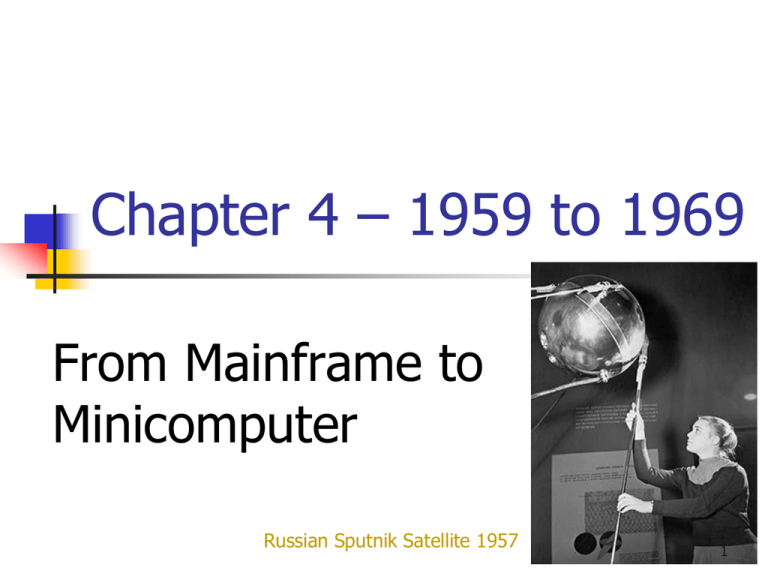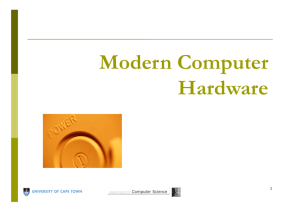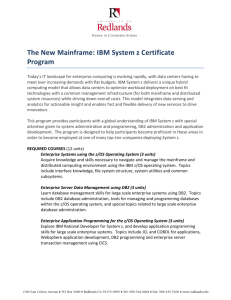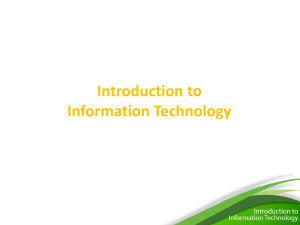Chapter 4 – 1959 to 1969 From Mainframe to Minicomputer
advertisement

Chapter 4 – 1959 to 1969 From Mainframe to Minicomputer Russian Sputnik Satellite 1957 1 State of Computing – 1960’s note: driving forces – pg. 110 Great Demand for Computing IRS: Mainframe + Punch Cards JFK: 1961 Moon Challenge Great economic growth & prosperity New computers – the MINI Technology already obsolete 2 IBM 1960 70% Market Share stability Research Labs (US, Europe)-slow payoff Could control market, releases (usually) Philco – transistor production Others need to find area unserved by IBM 3 Government Influence IBM 7000 Dept. of Defense - needed computer technology Researchers began defining work Demand for computing was heavy Govt. had funding – to lots of places See how this influenced the development 4 Massachusetts Blue Cross 1960 - IBM 7070; 1401 for I/O 6 months- transferred 2,500,000 records from cards to tape (150 file cabinets) AUTOCODER (not FORTRAN or COBOL) 1965 Medicare established Won job of administering for Mass. Fall 1966 - fully computerized - 1st state Also rented another 7070 (drove cards daily) 1969 - 3 IBM System /360’s + COBOL, 24-7 5 NASA- Ames Research Center Mountain View, California, 1940 Soviet Sputnik 1957 & JFK Moon Challenge Honeywell H-800 for wind tunnel - real time + others for dedicated purposes Became part of NASA in 1958 DEC, Scientific Data Systems, EAI, IBM Demands on central computer grew 100% per year in 1960’s 6 NASA-Ames Research Center (cont.) Direct Couple System - 1963 7094, 7040 (I/O), 7740 (Remote Terminals) Replaced in 1968 with System 360 model 50 1969- System/360 model 67 For time-sharing, not a success 1971 –connection to new ARPANet 7 NASA-Ames Research Center (cont.) Timesharing not a success Design problems Incompatible work patterns No longer “real time” for wind tunnel Table 4.1 p. 118 – computers at Ames 8 IRS- Internal Revenue Service During WWII – need $ Taxpayers from 8 to 60 million Withholding Punch Card – 1948 IBM 650 - 1955 Kansas City regional center 1.1 million returns – test 1959 - authorized to computerize fully IBM won bid 1401 @ each regional center 7070 national center Still 400 million cards a year Changeover complete by 1967: cards to magnetic drum 9 IRS (continued) Honeywell H200 No NW – flew tapes/cards around TAS - Tax Administration System Late 1960’s – implement new ideas $650- $800 million Distributing computing to 10 centers Direct access via 8,000 terminals Network Lot of work in to security plans 10 TAS (continued) 1974 - Nixon resignation / IRS records Public questioned security 1977- Computerworld – GAO report “Proposed IRS system may pose threat to privacy” Congress held hearings – IRS no trusted Jan. 1978 - IRS dropped TAS 1985 - IRS system collapsed, bad press Congress approved change 11 Put a Man on the Moon Batch would just not work Needed lots of money for real-time Mercury Monitor (system software) Data could interrupt processor to note lifethreatening situations Trap processor: checked levels of priority; saved contents of registers Evolved to real-time version of System/ 360 O.S. a significant advance in system software12 Minicomputer New, Not a competitor to mainframe Driven by technology Factors defining Mini Architecture Packaging Third parties Price Financing 13 Architecture of Mini Short Word Implications Small addresses, values, instructions Instructions more complex Instruction “modes” With new transistors, processor still simple inexpensive and fast 14 First Mini at CDC 1957 - CDC (Jack Norris) developed 1604 Seymour Cray – CDC 160 1960 – CDC Model 1604 Designed model 160 for I/O Word = 12 bits 8,000 word memory Fast clock 160A sold for $60,000 (stand alone) 1963- Jack Scanllin, Scanllin Electronics 2-160A’s to provide online stock quotes to brokers 15 Digital Equipment Corp (DEC) Founded 1957; K. Olsen, H. Anderson Olsen: MIT Whirlwind; MIT’s TX-0 (transistors) 1957-Most advanced in world 1959 - PDP-1 designer Ben Gurley Designed to take full advantage of transistors (not a “re-fit”) 100,000 adds/sec; 4,000-6,000 8-bit words 16 PDP- 1 features Transistors DMA: defined mini architecture Interrupts: up to 16 levels circuits to handle in order 1 IBM channel cost more than PDP-1: $120K Sold about 50, only moderate success financially, but 17 very innovative. No I/O channels (with own memory) Fast, little effect on 1717processor Cheap and simple DEC’s Policies Customer Relations Contrast to IBM Sold Computers Encouraged customer modifications Had sophisticated customers Necessary - small company Manuals “A Sears- Roebuck catalog” for DEC products Sold cheap or gave away 18 PDP-8 -1965 Sold 50,000; 12-bit word Germanium transistors - faster Indirect addressing; Paged memory; innovations DECtape – portable, r/w both directions, like disk Price??? $18,000; down to $10,000 plus single–chip versions Very low; shocked industry Model 33 ASR - Teletype Corp. Used ASCII, ctrl & esc Keys (Photo Pg. 134) 19 PDP-8 (cont’d) Term: Minicomputer Tendency toward assembly language OEM – original equipment mfg. Added specialized equipment Early use LS-8 (by Electronics Diversified) Contained a PDP-8A Controlled lights for A Chorus Line PDP-8 on a potato picker (P. 136) 20 DEC Culture The Mill, Maynard, Mass. 1965- $15 mil. Revenues 1970 - $135 mil. Proud of differences – IBM Eventually competed with IBM - VAX Read P. 136-139 21 Chapter 4 – 1959 to 1969 From Mainframe to Minicomputer 22





